Light emitting diode illumination system
- Summary
- Abstract
- Description
- Claims
- Application Information
AI Technical Summary
Benefits of technology
Problems solved by technology
Method used
Image
Examples
embodiment 80
[0029]FIG. 3 shows an alternative embodiment 80 of the mirror elements 66 of FIG. 2 comprised of modified mirror elements 82 containing the addition of small holes 84 through which high pressure air would cool rod 14 by high pressure air impingement. The holes would be sufficiently small as to minimally affect the mirrored surface area of mirrors 82. High pressure air impingement has several times the film coefficient and thus heat transfer as compared to standard convected low pressure air. The effect of the slight increase in the index of refraction of the medium surrounding rod 14 on TIR would be minimal. If direct contact cooling fluid was used without the sides of the rod being reflective, the higher than air index of refraction of the fluid would result in more loss out through the sides due to the decreased TIR internal angle, thereby reducing overall LED module efficiency. The reason it may be important to provide a means of removing heat build up from the rod is that there ...
embodiment 120
[0030]FIG. 4 shows an alternative embodiment 120 of LED module 12 of FIG. 1 where two modules 12 have been positioned in sequence to form a single multi-spectrum source. For example rod 122 of 120 could be made of a luminescent material with properties similar to those described for rod 14 for which the excitation band is within the long wavelength ultraviolet spectrum in the region of 240 nm to 420 nm. The high transmission region of the material would be in wavelengths longer than 420 nm and its luminescence could be in the blue to blue-green spectral region. Likewise rod 124 could have similar absorption properties but comprise luminescence in the green to red region of the spectrum. Both rods 122 and 124 would be characterized by high transmission in the spectral region containing wavelengths longer that 420 nm.
[0031]The mirror 66 would act to reflect any light transmitted in the direction opposite output coupler 22 back toward 22. In this way, LED light module 120 could contain...
PUM
 Login to View More
Login to View More Abstract
Description
Claims
Application Information
 Login to View More
Login to View More - R&D
- Intellectual Property
- Life Sciences
- Materials
- Tech Scout
- Unparalleled Data Quality
- Higher Quality Content
- 60% Fewer Hallucinations
Browse by: Latest US Patents, China's latest patents, Technical Efficacy Thesaurus, Application Domain, Technology Topic, Popular Technical Reports.
© 2025 PatSnap. All rights reserved.Legal|Privacy policy|Modern Slavery Act Transparency Statement|Sitemap|About US| Contact US: help@patsnap.com



